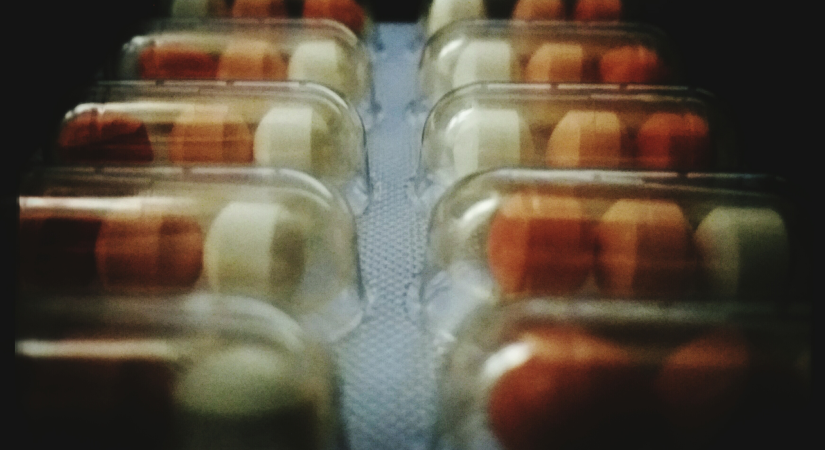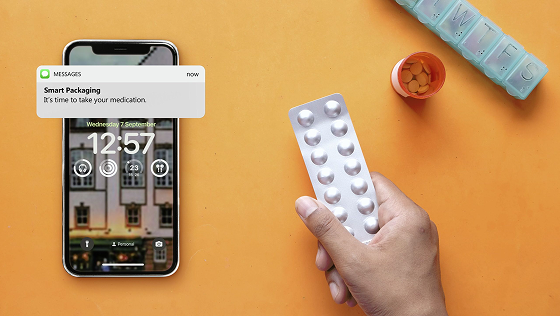by Ravindra Warang
6 minutes
Smart Blister Packaging: How IoT and AI Are Transforming Patient Adherence
How smart blister packs powered by AI and IoT are transforming patient adherence in pharma.

On her second visit to the clinic, Meera's doctor noticed something strange. Despite being prescribed a vital daily dose for her hypertension, her readings hadn’t improved. “I take it every day,” Meera insisted. But a new smart blister pack told another story: she had missed five doses in the past two weeks. This wasn’t about forgetfulness; it was about visibility.
Enter smart blister packaging — the fusion of IoT in healthcare, sensors, and AI in Pharma that is quietly revolutionizing patient adherence solutions and effective medication management tools.
As chronic diseases rise and digital health innovations go mainstream, the once-passive pill pack is becoming an active participant in therapy through innovative features like real-time medication tracking and reminder systems for medication intake.
This article explores how smart blister packs work, the technologies behind them, use cases, and what this means for pharma, patients, and the future of patient-centered medication strategies. For a foundational overview of blister formats and functions, see our pharma blister packaging guide.
Why Traditional Blister Packaging Falls Short
While unit-dose blisters help reduce dosing errors and improve medication adherence, they often fall short due to traditional blister packaging limitations. One significant drawback is that they offer no way to track whether the patient actually took the medication. This gap creates:
- Missed doses that go unnoticed
- Lack of real-time data for healthcare providers such as doctors and caregivers
- Adherence blind spots in clinical trials, complicating adherence monitoring
Smart blister packaging addresses these challenges by making the package itself aware, connected, and intelligent.
To explore how traditional materials compare, check out our thermoform vs cold form blister packaging guide. By utilizing technologies like near field communication (NFC), these advanced systems provide real-time insights into patient behavior, ensuring consistent dosing schedules—especially crucial for older adults.
Implementing smart blister packages requires understanding frameworks like the Technology Acceptance Model (TAM) and Theory of Planned Behaviour (TPB) to facilitate adoption by healthcare professionals and patients alike. Customizable regimens tailored to individual needs further enhance compliance and health outcomes.
Integrating smart packaging with AI-driven in silico compound screening could also streamline drug development while robustly monitoring adherence throughout clinical trials.
What is Smart Blister Packaging?
Smart blister packaging uses embedded sensors, conductive materials, NFC chips, and printed electronics to monitor dose removal effectively. When a dose is taken, this event is recorded and transmitted in real-time via Bluetooth, Wi-Fi, or cellular networks to connected platforms or caregiver apps.

Source: Shore Group
“It’s like turning a dumb shell into a data-driven dashboard.”
Typical smart blister systems comprise:
- Printed circuit or sensor grid behind each cavity detecting activity
- Microchip or NFC tag enabling seamless communication
- Companion software including mobile apps, cloud portals, dashboards
- AI-driven insights on patterns, risks, interventions supporting reminders and digital notifications
Together these components provide data-driven medication management, improving health outcomes. The integration of AI also enhances pharmaceutical processes such as large molecule optimization.
Technologies Behind Smart Blisters
Smart blister packaging transforms medication adherence using IoT technologies including:
- RFID/NFC Tags: Wireless communication with nearby devices tracks patient adherence
- Printed Electronics: Electronic components integrated directly onto lightweight flexible packaging
- Conductive Traces: Thin conductive pathways enable electrical communication within the blister
These combined technologies send real-time usage information to cloud platforms providing valuable insights into patient behavior. For more on barrier materials and how they influence smart integration, explore PVC, PVDC, and Aclar blister materials. This data facilitates advances in AI applications across pharmaceuticals including drug discovery.
Key Innovations
A major breakthrough is Bluetooth Low Energy (BLE) chips which enable easy data extraction from electronic modules monitoring when doses are taken. BLE supports remote compliance monitoring during clinical trials and provides AI-powered pharmacovigilance insights by analyzing pharmacokinetics/pharmacodynamics.
These innovations also help stratify patients in trials based on molecular profiles ensuring personalized treatment approaches.
How It Works
Patients using smart blisters receive customized reminders and digital notifications tailored to their schedules promoting adherence. The system combines healthcare technology integration with patient engagement strategies leading to better outcomes.
By leveraging natural language processing capabilities, reminders adapt based on user preferences further enhancing compliance. This synergy addresses challenges like supply chain disruptions and cybersecurity within pharmaceutical environments.
1. Conductive Traces in Smart Blister Packaging / Printed Electronics
- Printed conductive ink tracks activate when pressure is applied to a cavity, enabling dose detection.
- These low-cost, flexible solutions enhance dose-taking adherence, incorporating IoT principles supported by behavioral models like COM-B.
Researchers use ethnographic methods, ensuring designs meet pharmaceutical application demands while facilitating interaction between devices and users. Many of these innovations are built into systems from the top blister packaging machine manufacturers globally.
2. RFID / NFC Tags
- Enable tracking through scanners or smartphones essential for polypharmacy management
- Support pharmacy fulfillment processes improving efficiency with patient feedback loops via NFC tags
- Assist healthcare providers by simplifying complex regimens through real-time intake monitoring
Integration with wearable devices alongside software like MEMS® Adherence Software v4 enhances usability among participants supporting assessments using tools such as MARS-5 for adherence verification.
AI integration optimizes clinical trial data collection allowing investigation into its impact on trial quality and patient data management.
Elderly and Caregiver Use Cases
For caregivers managing Alzheimer’s or Parkinson’s patients:
- Confirming dose taken improves self-report adherence enhancing medication management effectiveness
- Reduces need for manual logs or supervision easing caregiver burden through smart packaging support
- Integrates with smart speakers providing alerts aiding timely intake for Parkinson’s patients
These benefits address barriers while highlighting facilitators like pill counting and improved communication demonstrating AI’s potential in pharma use cases improving patient care. Smart systems also complement traditional blister leak detection methods to ensure both monitoring and physical integrity.
Benefits for Pharma
Smart blister packaging offers pharma multiple advantages including:
- Improved Adherence Data: Real-world evidence (RWE) studies leveraging real-world data (RWD) highlight benefits
- Better Pharmacovigilance: Links adverse events with adherence patterns, enhancing drug safety monitoring
- Reduced Trial Risk: Real-time feedback prevents blind spots, reducing risks during clinical studies involving chronic disease patients
- Brand Differentiation: Adds value through telecommunication-enabled packs, setting brands apart in competitive markets
The Challenges
Despite promise, challenges remain:
- Higher cost per unit though dropping with maturity of technology
- Data privacy/security concerns around wireless transmission of sensitive information
- Battery limitations powering interactive features pose constraints
- Need for integration with existing pharmaceutical packaging lines
Major stakeholders continue investing in exploring features/benefits especially under outcome-based care models integrating patient behavior insights alongside addressing supply chain disruptions using AI tools including large language models (LLMs). These advances also align with sustainability goals through PVC-free blister packaging solutions that reduce environmental burden.
The Future: Predictive, Preventive, Personalized
The future points toward:
- Passive wireless sensors eliminating battery dependence
- AI-driven early warnings predicting non-adherence risks proactively
- Collaborations between pharma & payers linking reimbursements to adherence metrics. Combined with serialization in blister packaging, smart systems close the loop between manufacturing, adherence, and traceability.
Traditional packaging evolves into connected care platforms enhancing patient engagement across therapy journeys.
💡 Pro Tip: For oncology, CNS disorders or rare disease therapies—smart blister technology offers an edge gathering real-world adherence data aiding market access discussions combined with personalized medicine & AI strategies enhancing therapeutic success.
FAQs (Frequently Asked Questions)
1. How does smart blister packaging differ from traditional blister packaging?
Traditional packs lack tracking capability; smart blisters embed sensors & communication tech (RFID/NFC/BLE) enabling live monitoring of medication intake supporting advanced adherence systems especially critical during clinical trials.
2. What technologies are used in smart blister packaging to monitor medication use?
Embedded sensors detect pressure on cavities; conductive traces transmit signals; NFC/RFID tags enable wireless tracking; BLE chips provide continuous data transmission; accompanied by software apps/cloud dashboards offering AI-driven pattern analysis.
3. What are the benefits of smart blister packaging in clinical trials and chronic disease management?
Clinical trials gain accurate drop-out reduction & dose logging; chronic disease management benefits from missed dose alerts & telehealth integration improving treatment outcomes such as hypertension control through SMS reminders linked with symptom tracking.




